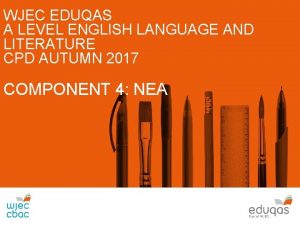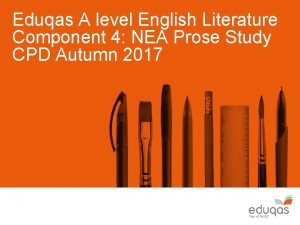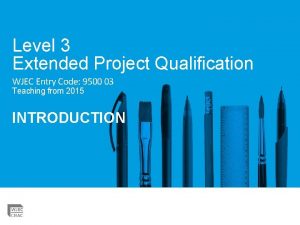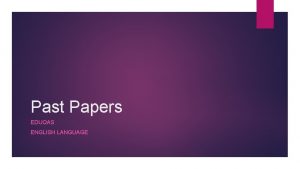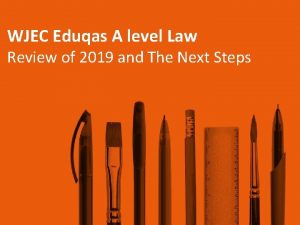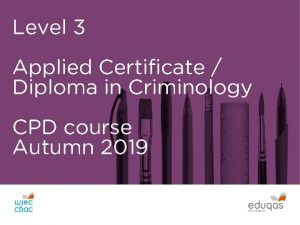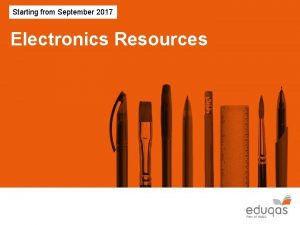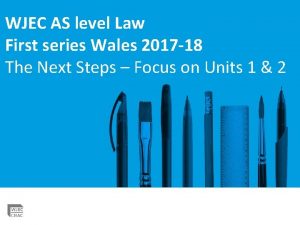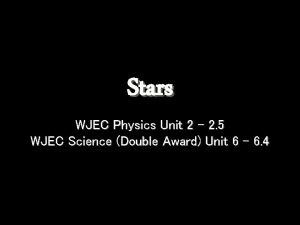WJEC CPD ENGLISH LANGUAGE A LEVEL AUTUMN 2016
















- Slides: 16

WJEC CPD ENGLISH LANGUAGE A LEVEL AUTUMN 2016 Unit 4: Spoken Texts and Creative Recasting

Specification • Section A (Spoken Texts): Response to 2/3 transcripts with a common language issue • Section B (Creative Recasting): Creative writing task using transcript(s) as stimulus

Section A: Spoken Texts • AO 1: Apply appropriate methods of language analysis, using associated terminology and coherent written expression (20 marks) • AO 2: Demonstrate critical understanding of concepts and issues relevant to language use (10 marks) • AO 3: Analyse and evaluate how contextual factors and language features are associated with the construction of meaning (10 marks)

AO 1: • analyse the transcripts and explore effects; • use appropriate spoken language terminology to describe and analyse examples; • address wider language features using a range of linguistic terminology; • engage with the texts, analysing and interpreting key features; • use an appropriate formal style—express ideas logically, clearly and accurately.

AO 2: • demonstrate knowledge of genre; • demonstrate knowledge of a range of spoken concepts and relevant theorists; • consider relevant language issues e. g. appropriateness/acceptability, role of expert, social status, occasion, gender etc; • provide relevant examples to support each point made.

AO 3: • demonstrate an understanding of how context shapes language use and points of view about language; • interpret examples and show meaning is created; • use appropriate terminology to explore the effect of key language features; • consider the effectiveness of communication.

Differences from LG 4 • Use of IPA • How are you planning to introduce this new element? • Greater range of prosodic features in the transcript • How do you introduce these? • No AO 4

Close Reading Often language students tend to ‘feature spot’. They need to ‘dig deep’ into meaning. Meaning should feed into AO 2 and AO 3. Three AOs = three pronged attack.

Starter activity How do you introduce close reading to students? • Look at the pictures – you have 10 seconds to write down your ideas. • Look more closely – you have 1 minute. • What’s the difference? • How does the context influence the meaning?

Observational vs interpretative approach; using annotation as a starting point for analysis Plural pronoun Inclusive; unifies presenters and crowd Context? Increased pace Implies excitement Context? accel Predictive Adjective Suggests it’s a fairytale or dreamlike scene Modified noun phrase Conveying mood of crowd Deixis (demonstrative determiner) Linked to purpose-informing viewer Raised pitch Indicates awe Context? we’ve been waiting for some time (2) as have this very expectant crowd just below {laughs} the kstudio and suddenly this kwave of energy approaches and (2) the hbelfryh it it’s literally just like a floating cathedral I mean (. ) the sound is just imagicali Simile As above for metaphor; implies splendour of the sound Comment clause Suggests bewilderment at the scene Metaphor Poetic compared to rest of language; implies crowd’s ecstatic mood Adverb Used for emphasis (not actually true) Non fluency (Unintentional repetition) Linked to context- live programme

Developing analysis • Three pronged attack. • Analysis of language should include all three AOs.

How to use AOs effectively • Read response extracts and put in rank order from best to worst. • Which responses are using all three AOs most effectively and why?

Section B - Creative Recasting • AO 2: Demonstrate critical understanding of concepts and issues relevant to language use (10 marks) • AO 5: Demonstrate expertise and creativity in the use of English to communicate in different ways (30 marks)

• AO 2: confident interpretation of the task e. g. genre and purpose; confident understanding of concepts and issues relevant to language use. • AO 5: sophisticated and appropriate expression; confident and conscious linguistic/stylistic choices; highly original with real flair; form and content skillfully linked to genre/purpose.

Writing tasks In materials pack, you will see four tasks related to the Section A transcripts. • Wide range of tasks from a variety of genres • Students will be prompted to use the transcripts in Section A as stimulus Can you think of any other tasks?

Cwestiynau? | Any Questions? Cysylltwch â’n Swyddogion Pwnc arbenigol a thîm cefnogaeth weinyddol eich pwnc os oes gennych unrhyw gwestiynau. kirsten. wilcock@wjec. co. uk gceenglish@wjec. co. uk @wjec_cbac @cbac_wjec cbac. co. uk wjec. co. uk Contact our specialist Subject Officers and administrative support team for your subject with any queries.
 Wjec a level english language and literature
Wjec a level english language and literature Eduqas a level english language
Eduqas a level english language Eduqas a level english language and literature
Eduqas a level english language and literature Eduqas english literature mark scheme
Eduqas english literature mark scheme Eduqas a level english literature
Eduqas a level english literature Eduqas a level english literature
Eduqas a level english literature Wjec epq
Wjec epq Ruby lennox paper
Ruby lennox paper Ra 10912 - cpd act
Ra 10912 - cpd act Levels of language knowledge
Levels of language knowledge Eduqas a level music resources
Eduqas a level music resources Unit 4 criminology wjec
Unit 4 criminology wjec Wjec a level music
Wjec a level music Criminology unit 3 controlled assessment
Criminology unit 3 controlled assessment Eduqas online exam review
Eduqas online exam review Wjec hospitality and catering
Wjec hospitality and catering Eduqas a level law
Eduqas a level law

